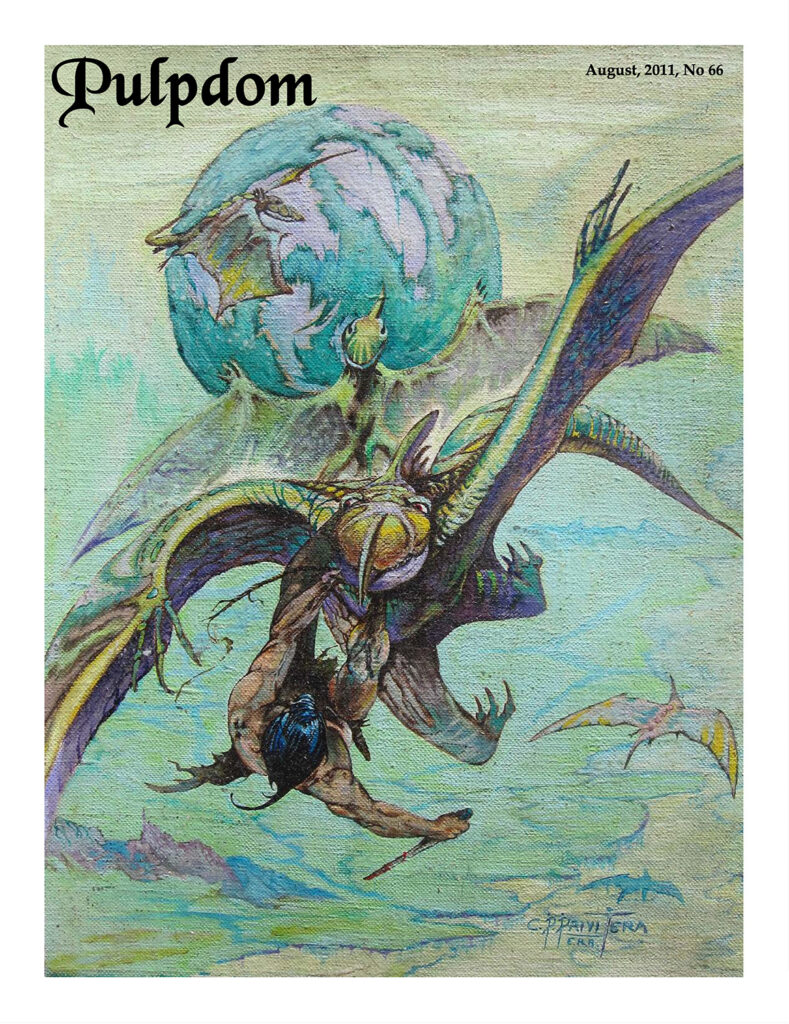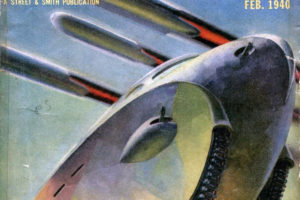 As with other issues, these are all 28 to 32 pages, side-stapled, reprinting early pulp fiction with various non-fiction articles and artwork, both new and old, also focused on the early pulps. In some issues, the non-fiction works are more prominent, in some cases pushing out any fiction reprints, and for me, these are almost more interesting. All have color covers, with some interior color.
As with other issues, these are all 28 to 32 pages, side-stapled, reprinting early pulp fiction with various non-fiction articles and artwork, both new and old, also focused on the early pulps. In some issues, the non-fiction works are more prominent, in some cases pushing out any fiction reprints, and for me, these are almost more interesting. All have color covers, with some interior color.
With this fanzine, you also need to pay attention to letters, editorials, and the like, as there is useful and interesting information there, as well as in the more formal articles. Often these are follow-up and additions to articles and items from prior issues.
■ #61 (July 2010): This issue completes the reprint of E.F. Bacon‘s “The City of Gold” from All-Story in 1911.
■ #62 (September 2010): The cover is by Craig Black this time with Barsoomian airships in a fight. This ties to Mike Taylor‘s next article on All-Story, now up to 1912. Which is when Edgar Rice Burroughs had both the first John Carter story as well as Tarzan. With color covers and interior artwork. We also get a reprint from All-Story, Francois Soulvain‘s “Stone Gods.” It’s a lost-world tale of a lost white race living in an extinct volcano in Africa.
We get several reviews. Gustave Aimard‘s Indian Scout: A Story of the Aztec City, a dime novel from 1861. Edwin L. Sabin‘s The City of the Sun (1924). Both are lost-world tales with young protagonists dealing with lost group of Aztecs. And Comte Villers de L’Isle’Adam‘s “The Future Eve,” which was written in France in 1884, then reprinted as a serial in Argosy in 1926, more an adaption then a translation. It’s apparently been re-translated and re-published in English twice. And finally, Paul Malmot‘s The Chinatown Death Cloud Peril, which I’ve reviewed here.
Lastely, when the series of reviews of Argosy ended with the last pulp issues in 1943, I noted it had become more a “men’s adventure magazine.” So we get a look at the rest of that year of it as such.
■ #63 (November 2010): Has another G.M. Farley cover, and a focus on the 1913 stories by Burroughs. We continue with Mike Taylor’s look at All-Story, now with 1913. Burroughs had “Gods of Mars,” “The Cave Girl,” “The Monster Men” (published here as “A Man Without a Soul”), and the beginning of “Warlord of Mars” in All-Story. But “The Return of Tarzan” appeared that year in New Story Magazine, after it and “The Outlaw of Torn” were rejected by All-Story! And of course, color covers and interior artwork. And a brief blurb on New Story (see Pulpdom #41 for more details). We also get a reprint from All-Story that year: Edward S. Pilsworth‘s “Spawn of Infinitude,” which was later reprinted in Famous Fantastic Mysteries. Set in the Andes, a meteorite lands near a group of explorers, and spawns weird aliens, who are later destroyed.
For reviews we get Fenton Ash‘s A Trip to Mars (1909). As noted, Fenton Ash is really Frank Aubrey, used for his boy books (see Pulpdom #49). I remember seeing the cover in my books on science-fiction, with the boy protagonists meeting the winged people of Mars. An inexpensive paperback reprint does appear on Amazon. And A Guide to Barsoom (1976) by John Flint Roy.
■ #64 (April 2011): Another cover with artwork by Craig Black of Barsoomian airships in a fight. We continue our look at All-Story, now up to 1914, again with lots of color covers. While several works have been reprinted, others not. From Burroughs this includes the next Tarzan novel, “The Mucker,” and the first Pellucidar novel. We also get some reviews. One is for John Wyndam‘s “The Secret People” (1935), that appeared under the name of John Beynon Harris. I’ve seen the Lancer edition years in used bookstores, but not sure if I got and read it. And Everett McNeil‘s The Lost Nation (1918)
 ■ #65 (June 2011): We have a cover by Jim Garrison tied to this issue’s article, the first of a three-part “Pellucidar Revisted” by Mike Taylor that starts with the first 3 Pellucidar novels. We get color covers, interior art and more. Pellucidar was the second Burroughs series I read, after John Carter. I never got into Tarzan, at least the novels. The third Pellucidar novel, “Tanar of Pellucidar,” actually appeared in The Blue Book, which is where Burroughs had his works for a period of time.
■ #65 (June 2011): We have a cover by Jim Garrison tied to this issue’s article, the first of a three-part “Pellucidar Revisted” by Mike Taylor that starts with the first 3 Pellucidar novels. We get color covers, interior art and more. Pellucidar was the second Burroughs series I read, after John Carter. I never got into Tarzan, at least the novels. The third Pellucidar novel, “Tanar of Pellucidar,” actually appeared in The Blue Book, which is where Burroughs had his works for a period of time.
■ #66 (August 2011): This time we have a Pellucidar/Tarzan cover by Paul Privitera. Appropriate as the bulk of the issue it taken by Mike Taylor’s “Pellucidar Revisted II,” covering 1929 to 1937, with lots of artwork, both color and black & white. This period starts with “Tarzan at the Earth’s Core,” which follows “Tanar.” This work first appeared in The Blue Book in 1929, and crosses the two series. The next Pellucidar story is “Back to the Stone Age,” which appeared in Argosy in 1937.
We get a review of “Earth’s Last Citadel” by C.L. Moore and Henry Kuttner from Argosy (1943). And with this, we get a brief look at some of the selected works in the final 8 pulp issues of Argosy, January to August 1943, along with the covers. After that, it would transform into a men’s adventure magazine.
■ #67 (Oct 2011): Has another Burroughs inspired G.M. Farley cover. Mike Taylor concludes with “Pellucidar Revisted III,” covering the final two Pellucidar novels, based on work by David Critchfield. He then covers related works that came later, such as comicbooks and others. He mentions the John Eric Holmes authorized sequels. I wish with the new stuff the Estate is releasing they can reprint these.
We get two early pulp reprints. “The Golden Rainbow” by George Ethelbert Walsh and “Votes for Men” by Percy Atkinson from different issues of All-Story Cavalier Weekly in 1914. One is a lost world tale, the other a satire.
■ #68 (February 2012): Has a wrap-around cover (sort of) by Craig Black that ties to the reprinting of Homer Eon Flint‘s “King of Conserve Island” that ran in All-Story in 1918. It’s a sequel to “The Planeteer” that was reprinted in Pulpdom #38-40. The reprint will conclude in the next issue.
Rounding things out are two reviews. One is of Gene Christie‘s collection, “The Space Annihilator,” a collection of early sf from The Argosy published by Black Dog Books. The other is Fenton Ash (aka Frank Aubrey)’s The Black Opal (1915), an adventure tale aimed at British boys.
■ #69 (April 2012): Has a cover by Craig Black that ties into the main article this time: a look into lost cities which are derivates of Ophir by Mike Taylor. Ophir was mentioned in the Bible and first used in H. Rider Haggard’s King Solomon’s Mines. Since then, many others have had their own Ophirs. Fenton Ash did one, By Airship to Ophir. And of course Tarzan’s Opar is based on it, and Philip José Farmer did a series based on ancient Opar.
■ #70 (May 2012): Another cover by Craig Black this time. We have the start of another fiction reprint and another article. We get the first half of a reprint of L. Patrick Green‘s “Gold from Ophir” from Short Stories in 1924. From Mike Taylor we get “Paleofiction” which looks at the better known works about primative man.
 ■ #71 (August 2012): Has a cover of John Carter fighting Green Men of Mars by ??. This issue is devoted to “100 Years of Edgar Rice Burroughs.” We get some additions to last issue’s “Paleofiction.” A review of the then recent John Carter movie. A review of “Under the Moons of Mars,” a collection of new Barsoom stories. Georges Dodd gives a bio of William Murray Graydon, who wrote several works including The White King of Africa, which was itself reviewed in Pulpdom #10. A review of a couple of books in the Mowgli theme: The Jungle Boy or, Sexton Blake’s Adventures in India (1902) by William Murray Graydon and The Lost Kingdom (1951) by Chester Bryant. Another review of Charles Beadle‘s The Land of Ophir, reprinted from Adventure by Off-Trail Publications (2012).
■ #71 (August 2012): Has a cover of John Carter fighting Green Men of Mars by ??. This issue is devoted to “100 Years of Edgar Rice Burroughs.” We get some additions to last issue’s “Paleofiction.” A review of the then recent John Carter movie. A review of “Under the Moons of Mars,” a collection of new Barsoom stories. Georges Dodd gives a bio of William Murray Graydon, who wrote several works including The White King of Africa, which was itself reviewed in Pulpdom #10. A review of a couple of books in the Mowgli theme: The Jungle Boy or, Sexton Blake’s Adventures in India (1902) by William Murray Graydon and The Lost Kingdom (1951) by Chester Bryant. Another review of Charles Beadle‘s The Land of Ophir, reprinted from Adventure by Off-Trail Publications (2012).
Mike Taylor provides an article on western pulp author Jackson Gregory (1882-1943), but did write some non-typical works like Ru the Conqueror and Daughter of the Sun. We get a reprint of “The Human Spark” by John Eyton.
■ #72 (October 2012): Reprints the cover from All-Story Weekly for October 30, 1915 by Modest Stein. The cover highlights “Mask of the Red Garden” by Rothvin Wallace, the first half of which is reprinted here. We also get part one of an examination of All-Story for 1915 by Mike Taylor, with lots of covers reproduced in color. There is also a review of Jane: The Woman who Loved Tarzan (2012).
■ #73 (April 2013): Under a cover of “Korak” by Paul Privitera, we get a couple of items. First is an article on pulp author Charles B. Stilson by Mike Taylor. Stilson is known for “Polaris of the Snows” trilogy and other works, many of them are covered here. Next is the conclusion of Mike Taylor’s review of All-Story in 1915. We get the final part of “The Mask of the Red Garden” by Rothvin Wallace.
■ #74 (June 2013): This time we get front and back covers of mermaids by Craig Black. This leads to an article on “Mermaid Tales” by Caz & Mike Taylor.
And we get some reprints of mermaid tales with “The Gefilte Fish Girl” in Fantasy & Science Fiction in 1997 by Mike Resnick and “Doctor Hackensaw’s Secrets #7 The Secret of Life” in Science & Invention in 1922 by Clement Fezandie. And we continue the series of works on All-Story Weekly with 1916 by Mike Taylor. Again, with lots of color covers.
■ #75 (August 2013): We have an Egyptian-style cover artwork, based on a cover from Boy’s Own Paper in 1919. This ties to the reprint of “The Wrath of Ptah” by Rex A. Booth from The Cavalier in 1912. We get a review of Robert Silverberg‘s Thebes of the Hundred Gates and a short list of other science fiction works that tie to ancient Egypt.
We then get an article written by Philip José Farmer in 1972 for Pulpdom, but only now published entitled “Some Problems in Writing the Tarzan Biography” that hadn’t been published until now. Mike Taylor provides a good into to help understand where it fits in with his works. This piece will be reprinted in the upcoming The Man Who Met Tarzan from Meteor House. We get an article from Taylor on the works that followed and were inspired by Burroughs. And a wrap up on the works focused on the fantastical works in All-Story, this time covering 1917 through 1920, with several color covers. And finally another article from Taylor looking at a matter of plagiarism that impacted A. Merritt in the 1930s when an author submitted a story that seemed too similar to one of Merritt’s.
At this point it was supposed to be the end of Pulpdom. Instead, after #75, Pulpdom was relaunched as Pulpdom Online, and renumbered to #1. It was originally available online for a fee, with no hardcopies. though at some point, a small number of hardcopies were made and sold. However, with what should have been #25, Pulpdom Online was re-renamed Pulpdom and again renumbered, as Pulpdom #99, and #100 was put out. As I don’t have access to a complete set of Pulpdom Online, I have no idea when or if I’ll do a review of them. But they are available for purchase online, as are all the previous issues.



